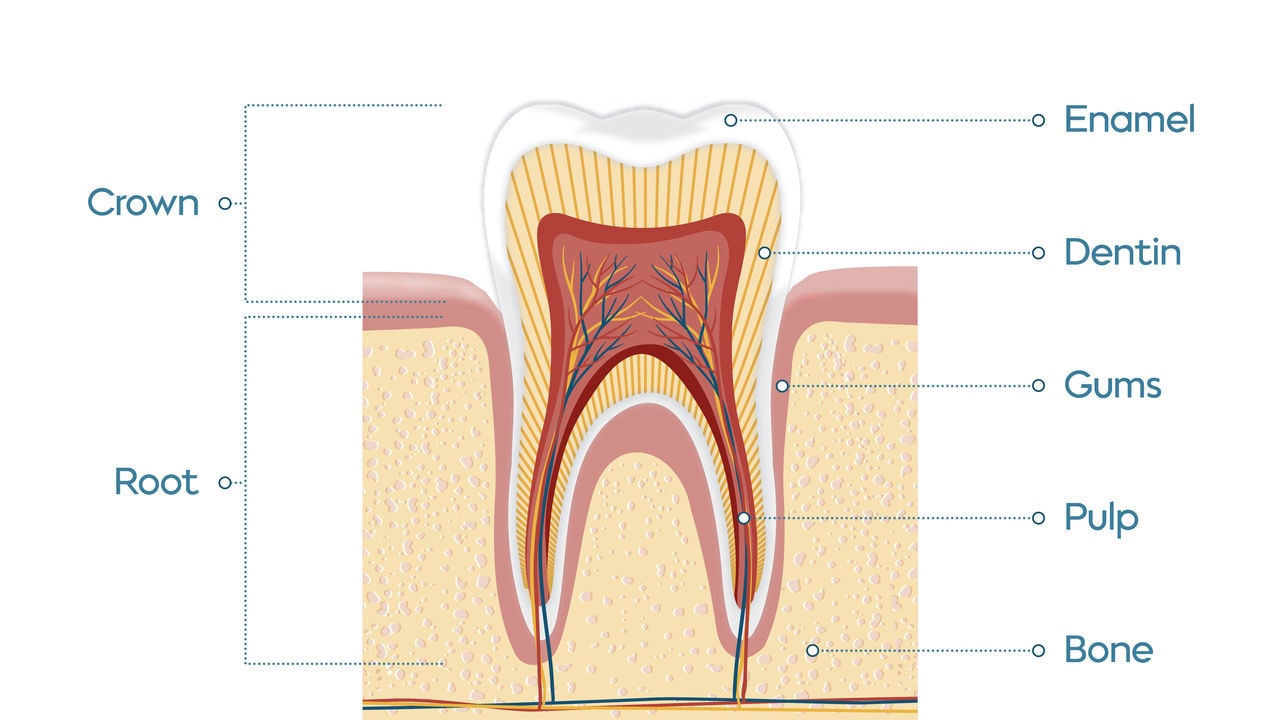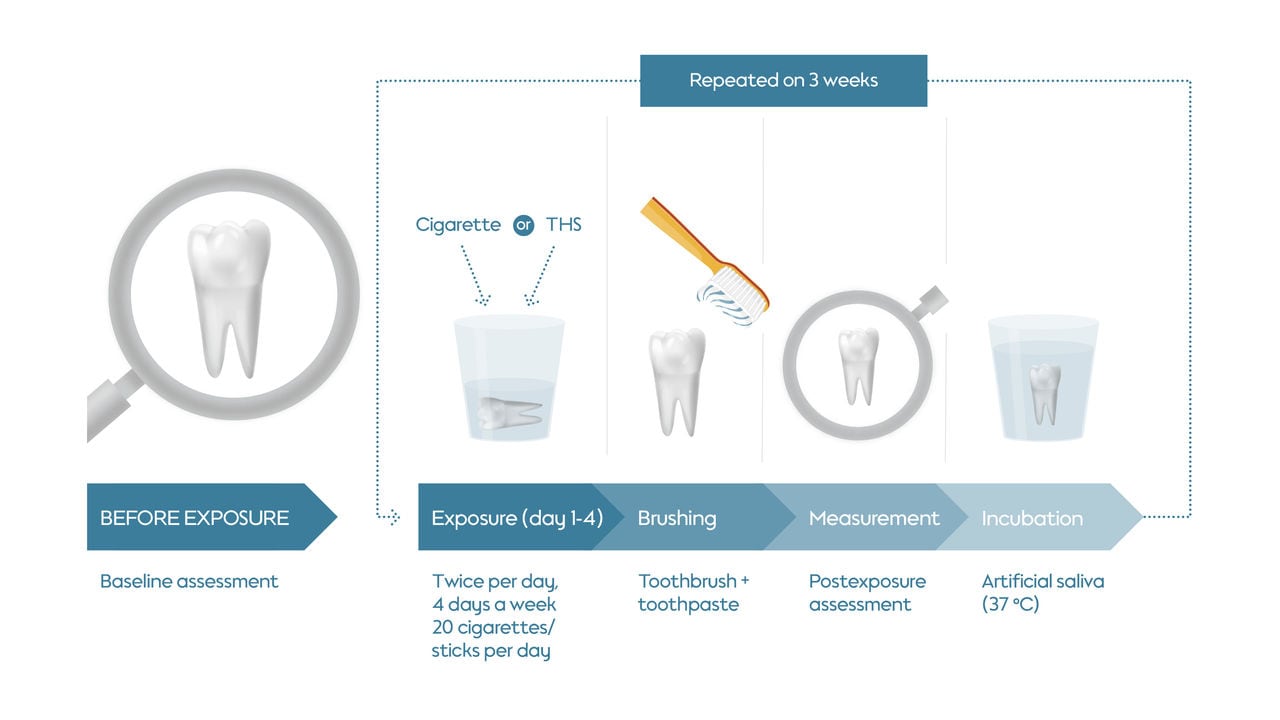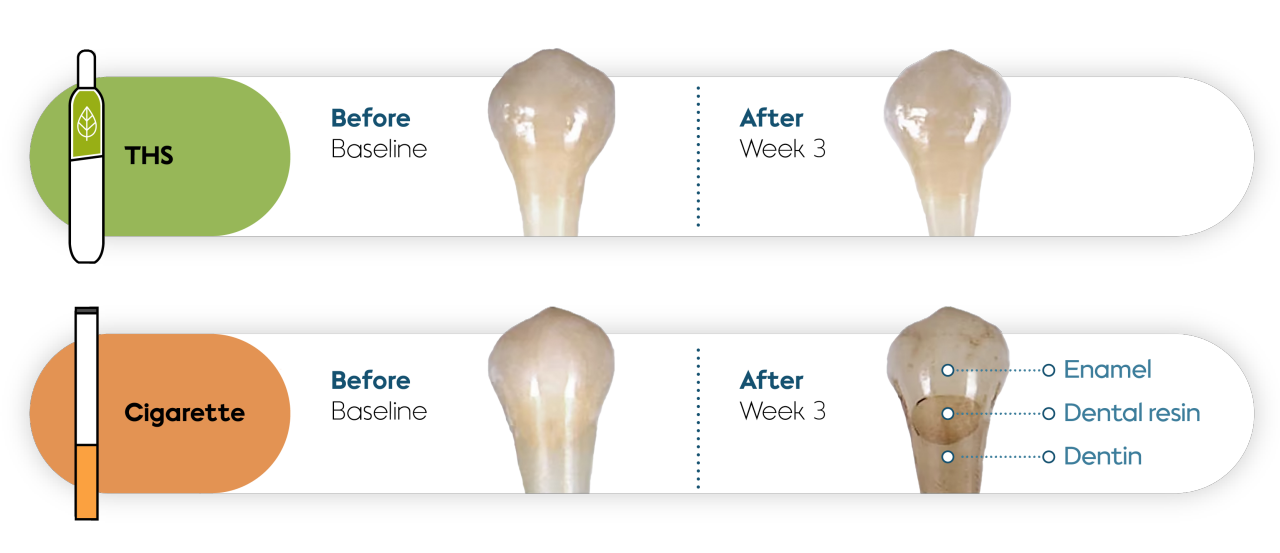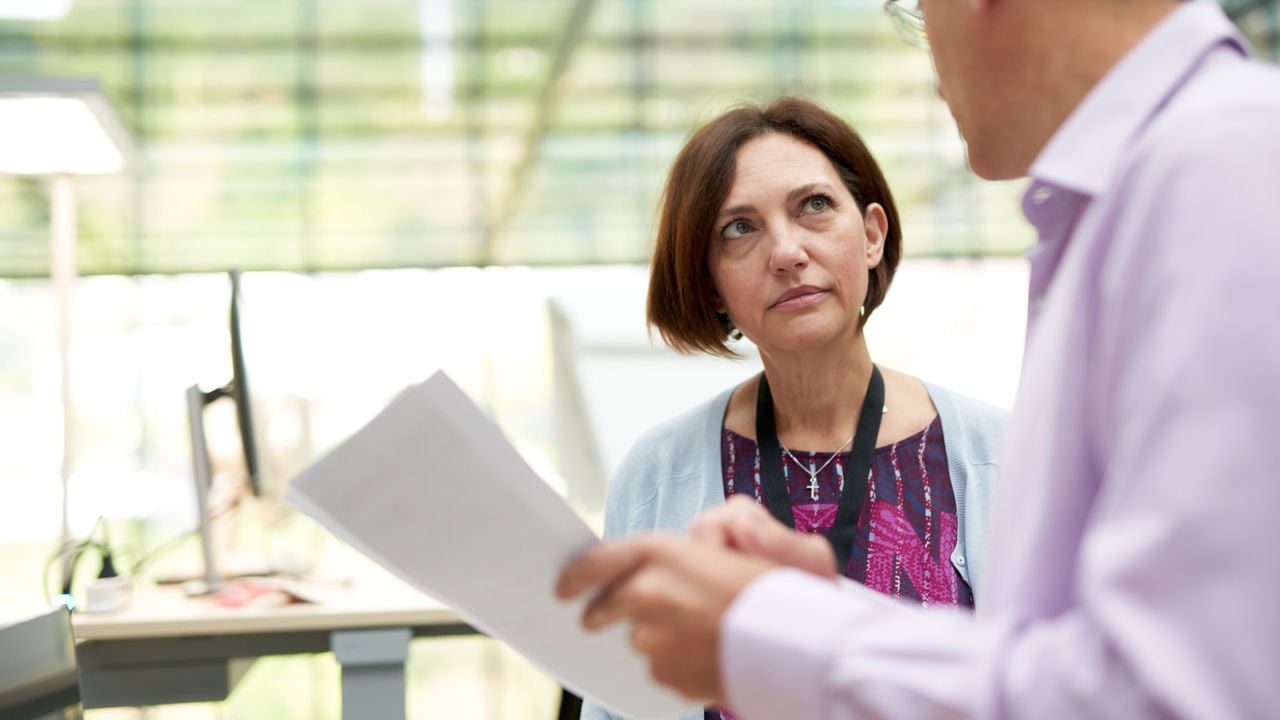Smoke-free product aerosols stain teeth and resins less than cigarette smoke
How cigarette smoke stains teeth
Cigarette smoke has been demonstrated to significantly stain enamel and dentin, causing noticeable discoloration and color mismatch between natural teeth and dental resins. A 2005 survey conducted in the U.K. indicated that the risk of severe tooth discoloration in smokers was 2.4 times higher than in nonsmokers.
Tooth discoloration from smoking occurs because the smoker’s teeth are exposed to thousands of chemicals found in cigarette smoke. This includes particulates and colored compounds that can adhere to the surface of the teeth and resin restorations, or penetrate the hard dental tissues, causing discoloration.

The tooth’s structure. The inner pulp of the tooth, containing the soft connective tissue, is covered by naturally yellow dentin. Dentin is naturally softer than enamel, which is the hard, outer layer of the tooth. The natural color of dentin ranges from light yellow to grayish white.
Cigarette smoke is a result of combustion, in which liquid (droplets) and solid (soot) particulate matters are formed. However, the process of combustion does not take place in the THS, and so the aerosol from THS does not contain solid particulates. As a result, we could expect to see reduced tooth discoloration compared with that caused by cigarette smoke, along with reduced impact on the color stability of dental resin composites.
The effects of cigarette smoke and THS aerosol on tooth discoloration
To better determine the extent to which THS aerosol affects tooth discoloration, our researchers compared the effects of cigarette smoke and THS aerosol on human teeth and dental resins. Their focus was on the level of discoloration, if any, caused by THS and whether THS use would lead to any color mismatches between dental resins and teeth.
Dental resins were applied to premolars that were extracted for orthodontic reasons. The teeth were then exposed in a laboratory setting to THS aerosol or cigarette smoke—twice a day, 4 days a week, for 3 weeks—and the teeth were brushed following a strict protocol simulating the human oral hygiene routine.

The color of the human premolar teeth and composite resin restorations were assessed in the CIE Lab space to establish baseline values. Each week after exposure to THS aerosol or cigarette smoke, the teeth were brushed with a toothbrush and toothpaste and assessed for color. When the teeth were not exposed to aerosol or being assessed, they were incubated in artificial saliva.
At the end of the 3 weeks, cigarette smoke caused an overall larger color change compared with THS aerosol. Teeth exposed to smoke showed decreased lightness and increased redness of the enamel, dentin, and composite resin restorations. THS aerosol caused similar trends in color change, including an increase in yellow color in the teeth, but to a much lesser extent—the color changes could not be seen with the naked eye. The THS aerosol also caused no measurable mismatch between the tooth and the dental resin, in contrast to cigarette smoke.

Comparison of the color change caused by THS aerosol and cigarette smoke. After 3 weeks, THS aerosol caused no obvious discoloration to the teeth and no color mismatch between the teeth and dental resins, unlike cigarette smoke.
While further research is needed, these findings suggest that THS poses fewer aesthetic risks to dental health compared with traditional cigarettes.
A better understanding of the compounds that lead to discoloration
In another study, our researchers aimed to systematically identify the specific constituents of cigarette smoke and THS aerosols which lead to tooth discoloration. To this end, they developed a method for extracting the colored chemical compounds deposited on tooth enamel following exposure to total particulate matter (TPM) from smoke or THS aerosol.
Bovine enamel blocks were used to eliminate the variability from human tooth morphology. Specimens were exposed to either cigarette smoke or THS aerosol for 14 consecutive days. At the end of each week, the specimens were brushed for 20 strokes (under 200 g of pressure and at a frequency of approximately 120 strokes per minute) without toothpaste to remove residual material from the enamel surface. Color was measured before and after each brushing session in the CIE Lab color space.
The enamel discoloration observed following exposure to cigarette smoke and THS aerosol confirmed the results seen in the earlier study with human teeth, in which THS aerosol showed no measurable color mismatch between the tooth and dental resin.
The study also identified eleven compounds associated with dental staining, which may have resulted from the breakdown of constituents in the tobacco, tobacco flavorings, or pyrolysis of plant material. Those compounds were significantly reduced or completely absent in THS-exposed enamel, while highly present in those exposed to cigarette smoke. Notably, nicotine was not associated with tooth discoloration in the study.
Effects of cigarette smoke and THS aerosol on resin restorations
Since the 1990s, resin composite has become a common alternative to dental amalgam in loadbearing situations in posterior teeth. This is due, in part, to resin’s superior aesthetics when compared with amalgam. Maintaining this aesthetic is important in avoiding early intervention or replacement of resin composites.
To measure the effects of cigarette smoke and THS aerosol on resin restorations, our researchers exposed commercial resin composite discs to cigarette smoke and THS aerosol for 3 weeks. The color, gloss, and surface roughness of the discs were measured at baseline, after exposure, and after brushing with toothpaste.
While the surface roughness of the resin composites was not affected by either cigarette smoke or THS aerosol, the discs exposed to smoke showed significantly more discoloration than those exposed to THS aerosol. Surface gloss was also increased in the discs with more severe discoloration. The results indicate that reducing the deposits derived from tobacco combustion may minimize the discoloration of resin restorations.
The effects of e-vapor aerosols on resin restorations
In addition to the study conducted with THS discussed above, we have also conducted research on the role of e-vapor products on resin restorations. The results of these studies support the conclusion that discoloration can be minimized by reducing exposure to tobacco combustion.
In one such study, resin composites exposed to cigarette smoke did not fully recover their original color after treatment with whitening toothpaste or take-home bleaching systems. At the same time, composites exposed to e-vapor aerosol returned to baseline color levels after treatment with whitening toothpaste, and no further change was observed following take-home bleaching.
A second study exposed human premolars with composite restorations to smoke, e-vapor aerosol, red wine, coffee, and soy sauce before conducting treatments with whitening toothpaste and take-home and/or dental office bleaching systems. While brushing with whitening toothpaste alone removed the discoloration caused by the e-vapor, a color mismatch remained between the teeth and the resin restorations exposed to red wine and cigarette smoke, even after take-home and in-office bleaching procedures. Notably, coffee and soy sauce staining could be reverted by means of hydrogen peroxide-based treatments.
However, more work is needed to determine if the positive effects of whitening treatments extend to resins exposed to THS aerosol.
The role of further studies
The studies highlighted here suggest that particles from combustion were a major source of discoloration of teeth and resins by cigarette smoking. While THS aerosol was also shown to cause some discoloration, this was much less than that caused by cigarette smoke.
Considering that the lack of combustion is an important factor in the reduced impact of THS on tooth color, we would also expect that other smoke-free products would have similar effects on tooth discoloration. This was observed in studies on e-vapor products, but more research is needed to determine the effects of THS and other smoke-free products on tooth and resin discoloration.
While additional research is needed, these findings suggest that smoke-free products like THS and e-cigarettes may pose fewer aesthetic risks to dental health compared with traditional cigarettes. Nonetheless, quitting tobacco and nicotine altogether remains the best strategy for maintaining oral aesthetics and overall oral health.
For more information about the effects of heated tobacco products on dental health:


